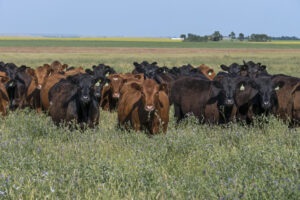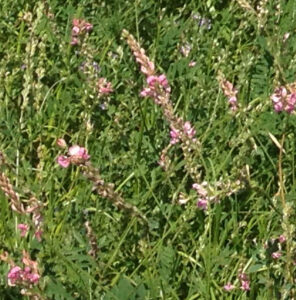Comparing Tame Forages Under Grazing 🎙️
CLICK THE PLAY BUTTON TO LISTEN TO THIS POST:
Listen to more episodes on BeefResearch.ca, Spotify, Apple Podcasts, Amazon Music or Podbean.
This article written by Dr. Reynold Bergen, BCRC Science Director, originally appeared in the June 2024 issue of Canadian Cattlemen magazine and is reprinted on BeefResearch.ca with permission of the publisher.
Since 2013, Canada has not required any testing or merit assessments before allowing a new forage variety to be registered. That has made it easier for breeders to get new varieties on the market but has made it harder for producers to know whether the new varieties are any better than (or as good as) the old ones.
Regional variety trials helped to fill this information gap, but these trials only focused on yield and sometimes forage quality. Forage performance under grazing is rarely examined. That’s important because mechanical plot harvesters don’t selectively graze, trample plants or deposit manure the way cattle do. Grazing trials take a long time and are very costly, but they provide very important information.
Dr. Bart Lardner and colleagues recently published the results of a forage variety grazing trial conducted at the University of Saskatchewan’s Livestock and Forage Centre of Excellence (Evaluation of cool-season perennial forage varieties as monocultures and legume–grass binary mixtures under intensive grazing; doi.org/10.1139/cjas-2023-0093).
What They Did

The team seeded tap-rooted alfalfa (Cronus), two creeping rooted alfalfas (3006 and Foothold), sainfoin (AC Mountainview), meadow bromegrass (AC Armada) and orchardgrass (AC Killarney), as well as each two-way grass-legume mixture. That adds up to 14 sets of plots (six monocultures plus eight mixes). Each individual plot was 21m wide by 125m long, the plots were seeded next to each other, then the whole area was fenced into a paddock. This was repeated three times, so there were three paddocks, each containing 14 adjacent plots. Over the next three years they collected samples for forage yield and quality during the grazing season. They also measured “etiolated growth” (an estimate of how much energy the plant has stored in the crown and roots to power spring regrowth) in 2020 and 2021. The amount of time cattle spent grazing each plot was also monitored.
What They Learned
Weather: Total precipitation for May through September at this location usually averages 200 mm. The plots were seeded in 2018’s drought (106 mm). The first two grazing years saw normal rainfall (212 and 199 mm) before the drought returned in 2021 (103 mm). So, these plots were established and grazed under challenging conditions.
Forage yield reflected the rainfall, with highest yields in year two. Over all three years, 3006 alfalfa was the most productive legume (2.3 T/ha) and Mountainview sainfoin was the least productive (1.5 T/ha). Cronus and Foothold alfalfas were intermediate (2 T/ha). Meadow bromegrass outyielded orchardgrass (1.5 vs. 0.7 T/ha). Yields of the two-way mixtures ranged from 0.9 to 1.5 T/ha and were not statistically different. That’s because bromegrass produced more yield than the legume in mixed plots, while higher yielding legumes helped make up for the lower yielding orchardgrass.
Forage quality: Alfalfa had higher protein and energy (TDN) and lower fiber (ADF and NDF) than sainfoin, the legumes had higher protein and energy and less fiber than the grasses, and orchardgrass had less fiber than bromegrass.
Grazing preference was highest for the straight alfalfa plots, while straight orchardgrass was the least preferred. The other varieties and mixtures were in between, but alfalfa-meadow brome crosses were generally preferred, and mixtures involving sainfoin or orchard grass were least preferred. This is interesting, as both sainfoin and orchardgrass had reasonable nutritional quality. Mountainview sainfoin may have been a bit less attractive to the animals because it was slightly more mature when grazing started. The effects of variety or mixture on cattle gains couldn’t be calculated, because each paddock contained all of the mixtures. No bloat was observed.
Etiolated growth (energy stores for spring regrowth) was also influenced by growing conditions. All forages stored similar amounts of plant energy in 2020 (the wet year). In the 2021 drought, energy stores were much lower in alfalfa (60% lower than in 2020), sainfoin (80% lower), meadow bromegrass (77% lower) and orchardgrass (86% lower).
So what does this mean… to you?

This was only one three-year project at one site in one soil zone, but it illustrates a couple of important points. The risk of bloat makes some producers reluctant to take advantage of alfalfa’s high yield and forage quality, but using a mixed alfalfa-grass stand is a way to get the quality, yield and palatability benefits of alfalfa while reducing bloat risk. In contrast, sainfoin is a bloat-safe legume, but Mountainview may not perform as well as alfalfa under drought conditions. Although Killarney orchard grass had a high nutritional value, it was not overly drought tolerant or palatable. Finally, the etiolated growth results are a sad reminder that severe drought during one growing season means that forages will have lower energy stores the next spring. That means less and slower regrowth early in the growing season requiring some tough decisions about balancing the need for feed with optimal turnout dates and stocking rates.
Bottom Line
Just because a new variety is registered doesn’t automatically mean that it’s better, and good yields in a plot harvest trial doesn’t mean it will stand up under grazing.
The Beef Cattle Research Council is a not-for-profit industry organization funded by the Canadian Beef Cattle Check-Off. The BCRC partners with Agriculture and Agri-Food Canada, provincial beef industry groups and governments to advance research and technology transfer supporting the Canadian beef industry’s vision to be recognized as a preferred supplier of healthy, high-quality beef, cattle, and genetics. Learn more about the BCRC at www.beefresearch.ca.
Le partage ou la réimpression des articles du www.BeefResearch.ca est généralement bienvenu et encouragé, mais cet article nécessite l’autorisation de l’éditeur d’origine.
Vos questions, commentaires et suggestions sont les bienvenus. Contactez-nous directement ou suscitez un dialogue public en publiant vos réflexions ci-dessous.